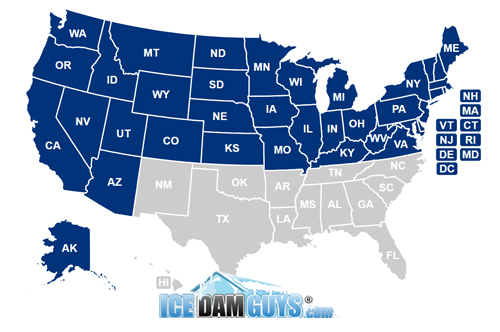How to Prevent Ice Dams If You Have Cathedral Ceilings
If you have cathedral ceilings you might run into issues with some of my advice on ice dam prevention. Why? Because most of my advice is for people who have attics, and you’ve got a cathedral ceiling, you simply don’t have an attic.
The good news is there are several ways you can prevent ice dams if you’ve got a cathedral ceiling. The bad news is you’ll need a good contractor to help execute them.
Have a contractor create an air barrier.
One of the best ice dam prevention articles that I’ve ever read is an analysis of the building, design, and renovation work of a contractor named Tony Woods. Tony focused his entire career on ice dam prevention (instead of ice dam removal). He highlighted air barriers as a technique for dealing with cathedral ceilings:
“In a cathedral ceiling, provide an air barrier between the top of the insulation and the ventilation channel. Site-built ventilation chutes (foamed or caulked in place) are far preferable to polystyrene Proper-Vents.”
Sounds like jargon to most of us, but a good insulation professional (preferably a scraggly old-timer) will know how to do it. He might also suggest some the other solutions (listed below). Air barriers aren’t always the best way to handle every ceiling, but it’s a great solution for most of them. Click here to see a diagram.
Re-insulate the ceiling.
Sometimes the ceiling simply doesn’t have enough insulation to keep the roof cold (which is what you want – a cold roof).
If your ceiling isn’t properly insulated and sealed, at some point you’re going to get ice dams. I’s only a matter of time. Correcting the problem may be expensive, but if you have 9 ice-dam-free years in 10, any work that you have done will more than pay for itself.
You may want to check out this case study, in which several insulation professionals weigh in. There’s even a discussion of air barriers versus other methods, like creating a tightly filled foam barrier.
Target attic bypasses.
An attic bypass is any non-insulated areas of your home where warm air can leak into your attic, including light fixtures, ceiling fans, attic hatches, outlets, light switches, ventilation/exhaust fans, and any other places where holes have been cut into your walls or ceilings. You’ll want to have an insulation contractor seal those up or insulate them better. A blower-door test is an excellent test to find and repair any attic bypasses!
Target heat sources in the roof space.
Sometimes homebuilders run hot-water pipes or heater ductwork through the attic space, but don’t think through the implications. If hot-water pipes run through your attic, you’ll heat up the roof every time you shower, wash your hands, wash a load of clothes, and/or run the dishwasher.
These pipes will need to be heavily insulated, or they’ll need to be removed and rerouted.
Install ice and water shielding to at least 6 feet.
Ice and water shielding can make a big difference here, at least in terms of your ability to defend against leaks. Minnesota code requires ice and water shields to extend from the drip edge of your overhang to at least 2 feet past an interior wall. Find a roofer who will extend your ice and water shield to at least 6 feet past interior walls (or even better – cover your entire roof with ice & water shield).
Install an ice belt.
As Tony Woods (an ice dam prevention expert) said:
An Ice Belt is really nothing more than a seamless piece of metal flashing installed along the overhangs and extends upwards towards the peak of the roof, to just past an interior wall. The idea is to cover any areas where ice dams typically form, and it serves two purposes: first it provides a smooth surface which allows the snow & ice to simply slide off of the roof, preventing most ice dams. Second, it provides an impenetrable surface that water can’t flow up under, as it does with shingles.”
Although I’d prefer ice-and-water shield over an ice belt, the benefit of an ice belt is that it can easily (and cheaply) be installed right onto your existing shingles without your needing to remove anything. It’s a great little add-on for homeowners who are desperate to stop ice dams, but who don’t have the money or desire to tear off a portion of their existing roof to add additional ice-and-water shield under their shingles.
Check your roof ventilation.
Roof ventilation is even more important if your home has a cathedral ceiling. You simply can’t afford to let that heat get trapped up there. Instead, you need to let the heat out from under your roof deck. And…because you don’t have room for enough insulation to simply “hold” all that heat back, you need to allow the heat to escape via ventilation. That is why ventilation is vital in a home with cathedral ceilings. No matter what you do, there will be some heat to contend with, and proper ventilation is the ticket to combat that heat. After all, it’s this very buildup of heat that causes ice dams in the first place.
Turn down the temperature.
You might want to lower the temperature in your house a bit and just put on a sweater to compensate. (Thank you, President Carter.) At the very least, don’t have it be a sauna inside your home. Try lowering the temperature to 55 degrees when you’re not in the house, and keeping it between 65 and 68 degrees when you’re home. Energy professionals will recommend that, too.
Keep in mind…
Like the common cold, there’s no cure for ice dams or an absolute prevention measure – cathedral ceilings or no. But the more of those home improvements you can put into action, the less likely it is you’ll get an ice dam.






















